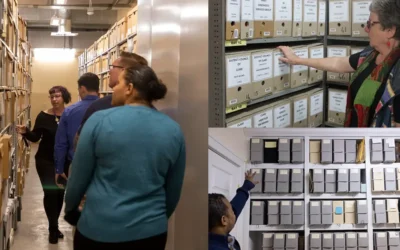Developing Goals and Objectives for Archival Projects
Margot Note
Goals and objectives are instrumental in strategic planning for archives because they turn the project’s vision into measurable targets. Goals are the ends towards which a project is directed; objectives are more detailed than goals and explain how goals will be accomplished. With both in hand, archivists build and support the vision for what they wish to achieve with their projects.
Goal-Setting
Goals describe the purpose of the archival project, while objectives express the steps necessary to achieve goals. The goals should be prioritized, so the team knows which goal is most important if a trade-off needs to be made. Document each goal and tie it to the project vision. Goals describe what you want to achieve in non-technical terms, and they should align with organizational strategy. They clearly define the outcome of the project so that everyone understands what is to be accomplished.
A goal statement is a point of reference for any questions that arise regarding the project’s scope or purpose. The sponsor and project manager must set expectations and encourage the refinement of the goals so that the team gains ownership of the project, builds cooperation, and reduces areas of conflict.
A goal should be presented in such a way that one can determine if it has been achieved. If the goal of the project is to produce a deliverable with a specified quality at a particular time and within a cost limit, it is easy to check whether the goal is achieved. Goal statements should be short and to the point. The goals should exclude any information that might commit the project to impractical dates or deliverables.
Discovering Objectives
Goals need to be translated into objectives if they are to be used for planning and guiding the project’s assessment. Objectives should define what is to be achieved, when it will be completed, and how it will be performed. Objectives are a more detailed version of the goal statements. The purpose of objective statements is to clarify the boundaries of the goals and define the scope of your project. Objectives specify a future state, rather than an activity.
They are statements that tell the project team what result is to be achieved. Problem-solving to determine methods of reaching objectives should be kept open so that solutions can be determined later. If the approach is written into the objectives, it may lock a team into a method that is unsuitable for the project in the long run.
Objectives range widely. Financial objectives refer to the budgets themselves or to the standards organizations employ to assess their performance. Examples of financial objectives include staying within budget, increasing revenue or profit, or cutting costs. Performance objectives include meeting deadlines, satisfying requirements, or conforming to specifications. Technical objectives relate to the implementation or improvement of technology. Quality objectives represent improvements in services.
Prioritizing objectives may help eliminate tasks if the commitment to your budget or completing the project on time becomes an issue. Priorities will also assist you if you need to reorganize the project or deploy team members. If two people are completing a task, and assistance is required with another task associated with a higher priority objective, you will be able to adjust the efforts to be most useful.
Being Smart about Objectives
Use the word SMART to remind yourself of the areas to consider when setting objectives. The acronym stands for specific, measurable, accurate, realistic, and time bound. Specific objectives tell exactly what, where, and how to address the need. Measurable objectives have metrics in place so that you know whether you have succeeded or not. Accurate objectives should be described in a precise manner, so errors are nonexistent. Realistic objectives should be achievable in the time allowed. Time bound objectives must include a precise date for achievement. You may also consider writing SMARTER objectives that are extending and rewarding. The objectives should stretch or extend the capabilities of the organization. Rewarding objectives may be more difficult to gauge, but the achievement of an objective that serves the parent body will often translate into greater support for the organization and the project in future.
Goals and Objectives: An Example
For an archives, one goal of a project could be to increase the use of primary sources in history education by encouraging cooperation between historical records repositories and educators. Several objectives may stem from that goal. For example, one objective may be to support a project of history educators and archivists to create history curriculum based on analog and electronic records. Another objective may be to develop models for student tours and the use of archival facilities. These objectives can be further broken down into activities, performance indicators, and possible leads for partnerships.
Being Flexible
As in planning, the process of developing objectives is continuous. As information becomes available, and as the project progresses, modifications that contribute to the achievement of the completed project should be made to the objectives. In the planning phase, the project is in flux, so archivists can revise their objectives later as they receive more information about their project.
Margot Note
Similar Posts
Enhancing Collaboration; Methods for Archivists
Archivists can enhance collaboration through user-centric approaches and efficient processing methods based on customer service principles.
Navigating Selection in Archival Practice
The archival selection process is far from straightforward, given the limitations of long-term preservation and ongoing accessibility challenges.
Responsible Stewardship in Archival Practice
Responsible stewardship is a philosophy that guides the actions and decisions of archivists in safeguarding collective memory.
A Modern View of a City’s History via ArchivEra
Brief success story on City of Regina Archives’ use of ArchivEra to manage collections of legal, historical, administrative or financial significance
Hosting service
Enjoy all of the benefits of your Lucidea solution with secure, reliable, stress free hosting
Programs & incentives
No matter your size or budget, we’ve got you covered, today and tomorrow



